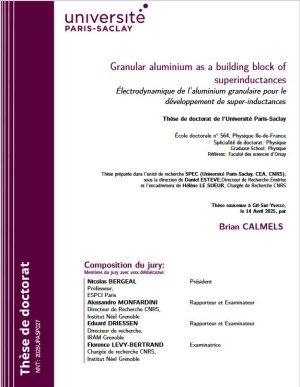Superconducting circuits are part of a growing group of hardware platforms which successfully demonstrated quantum information processing, from quantum error correction to quantum limited amplification. The development of quantum circuits for information processing requires the implementation of ultra low-loss microwave resonators with small dimensions. An important resource for resonator miniaturization is the kinetic inductance of superconductors, LK , which can exceed the magnetic (“geometrical”) inductance Lg by several orders of magnitude in narrow and thin superconducting films.
Due to its large critical current density compared to aluminum based Josephson junctions, its resilience to external magnetic fields, and its low dissipation, its high coherence in the microwave domain and its intrinsic non-linearity, granular aluminum (or GrAl), self-assembled nano-grains of aluminium in a matrix of AlOx is an attractive choice for superconducting hybrid systems operating at radio-frequencies.
In this PhD, we explore the possibility of using GrAl for obtaining superinductances with low microwave losses. Although GrAl has been successfully employed e.g. in fluxonium quantum bits, the realization of superconducting quantum processors still requires orders of magnitude improvements in coherence. This task is complicated by the fact that several types of imperfections, both microscopic and macroscopic, are concomitantly present, depending on system design, micro-fabrication technology, and materials.
We show that the great sensitivity of GrAl thin film properties to oxygen content during deposition leads to important reproducibility and homogeneity issues, and we bring several solutions to circumvent these inherent difficulties. In a second time, we characterize the superconducting properties of GrAl thin films (30 nm) resonators and investigate the best trade-off between having high kinetic inductance and a lossless material. In particular, we present resonator samples with kinetic inductances up to 4.5 nH/square with low photon number internal quality factors of the order of 105 We also investigate the microwave sources of noise in GrAl through resonator frequency noise spectral analyses.
Keywords: Disordered superconductors, Kinetic inductance, Electrodynamics, Granular Aluminum.


